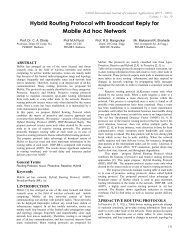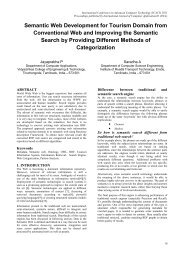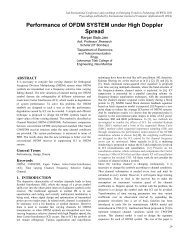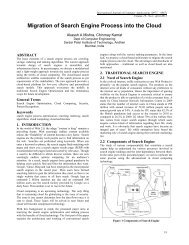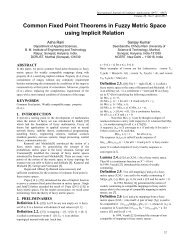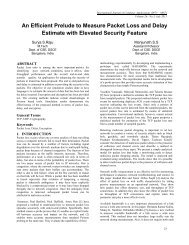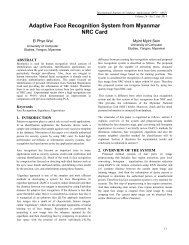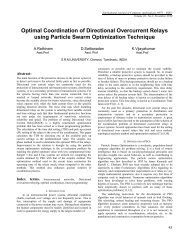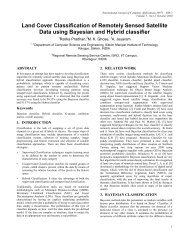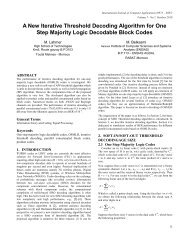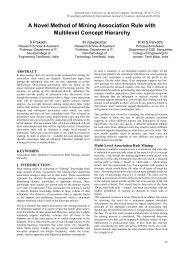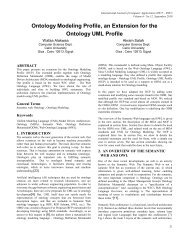Semantic Web Image Search through Manual Annotation
Semantic Web Image Search through Manual Annotation
Semantic Web Image Search through Manual Annotation
Create successful ePaper yourself
Turn your PDF publications into a flip-book with our unique Google optimized e-Paper software.
International Journal of Computer Applications (0975 – 8887)<br />
Volume 17– No.8, March 2011<br />
<strong>Semantic</strong> <strong>Web</strong> <strong>Image</strong> <strong>Search</strong> <strong>through</strong> <strong>Manual</strong> <strong>Annotation</strong><br />
M. Gokul Prasad<br />
Department of Software<br />
Systems<br />
Karpagam University<br />
Coimbatore<br />
T. Sumathi<br />
Department of Software<br />
Systems<br />
Karpagam University<br />
Coimbatore<br />
Dr. M. Hemalatha<br />
Department of software<br />
systems<br />
Karpagam University<br />
Coimbatore<br />
ABSTRACT<br />
Over years the searches made over web still remains non<br />
semantic. The internet media is filled with lot of unstructured<br />
data that results this state of non semantic search over web. To<br />
make the search more specific over the query given, its<br />
attributes are to be defined while the search along with its object<br />
name. By defining so the normal web search appears to be<br />
semantic. The attributes relevant to the context is made easy<br />
over text, audio and video files. Whereas <strong>Image</strong> files still suffers<br />
with its undefined attributes along with the relevant image being<br />
uploaded. Moreover the images over web aren‟t tagged yet with<br />
relevant attributes in them. JPEG, Bitmap and all other<br />
commonly used image supporters yet remain without tags. Only<br />
this leads a non semantic search over images on web.<br />
Keywords<br />
<strong>Semantic</strong> <strong>Web</strong>, image repository, tag attributes, Resource<br />
Description Framework (RDF), <strong>Web</strong> Ontology Language<br />
(OWL), manual annotation, automatic annotation, and Meta<br />
data.<br />
1. INTRODUCTION<br />
According to Tim Berners-Lee “The <strong>Semantic</strong> <strong>Web</strong> is an<br />
extension of the current <strong>Web</strong> in which information is given welldefined<br />
meaning, better enabling computers and people to work<br />
in cooperation”[2,27] .<br />
"The <strong>Semantic</strong> <strong>Web</strong> is a vision: the idea of having data on the<br />
<strong>Web</strong> defined and linked in such a way that it can be used by<br />
machines not just for display purposes, but for automation,<br />
integration and reuse of data across various applications"[3]<br />
.<strong>Semantic</strong> means adding meaning of data to be discovered by<br />
computers. It is a vision of a new architecture for the World<br />
Wide <strong>Web</strong>, characterized by the Association of machineaccessible<br />
formal semantics with more traditional <strong>Web</strong> Content.<br />
The core idea is to create the meta data describing the data,<br />
which will enable computers to process the meaning of things.<br />
The ultimate goal of the <strong>Semantic</strong> <strong>Web</strong> is to transform the <strong>Web</strong><br />
into a Medium, <strong>through</strong> which data can be shared, understood<br />
and processed by automated tools.<br />
<strong>Semantic</strong> <strong>Web</strong> techniques, which consist of applying knowledge<br />
representation techniques in a distributed environment<br />
(potentially on a <strong>Web</strong> wide scale), have proven useful in<br />
providing richer descriptions of <strong>Web</strong> resources [4].<br />
The <strong>Semantic</strong> <strong>Web</strong> extends the <strong>Web</strong> <strong>through</strong> the use of<br />
standards, markup languages and related processing tools.<br />
<strong>Semantic</strong> <strong>Web</strong> technologies enable people to create data stores<br />
on the <strong>Web</strong>, build vocabularies, and write rules for handling<br />
data. Linked data are empowered by technologies such as RDF<br />
and OWL.<br />
The vision of the <strong>Semantic</strong> <strong>Web</strong> is an extension of the existing<br />
<strong>Web</strong> <strong>through</strong> which machines are able to interoperate and work<br />
on our behalf. It promises to infuse the Internet with a<br />
combination of metadata, structure, and various technologies so<br />
that machines can derive meaning from information, make more<br />
intelligent choices, and complete tasks with reduced human<br />
intervention. <strong>Semantic</strong> web vision is oriented toward machinereadable<br />
resources rather than human-readable. It requires<br />
resource description so that machines know what they mean<br />
(metadata) [5].<br />
Currently, the World Wide <strong>Web</strong> consists of documents written<br />
in HTML. This makes the <strong>Web</strong> readable for humans, but since<br />
HTML has limited ability to classify the blocks of text apart<br />
from the roles they play, the <strong>Web</strong> in its current form is very hard<br />
to understand. The purpose of the <strong>Semantic</strong> <strong>Web</strong> is to add a<br />
layer of descriptive technologies to <strong>Web</strong> pages so that become<br />
readable. The <strong>Semantic</strong> <strong>Web</strong> is implemented in the layers of<br />
<strong>Web</strong> technologies and standards.<br />
2. SEMANTIC ANNOTATION IN<br />
IMAGES<br />
In general, manual annotation can provide image descriptions at<br />
the right level of abstraction. It is, however, time consuming and<br />
thus expensive. In addition, it proves to be highly subjective:<br />
different human annotators tend to "see" different things in the<br />
same image. On the other hand, annotation based on automatic<br />
feature extraction is relatively fast and cheap, and can be more<br />
systematic.<br />
In the process of image annotation, we may find values for<br />
attributes or relationships that are not previously present in the<br />
knowledge base. The process of enhancing the existing metadata<br />
could be as simple as entering values for attributes; in that case<br />
they could be automated. Moreover this process could be as<br />
complex as modifying the underlying schema, in that case some<br />
user involvement might be required [11].<br />
To annotate the images, RDF data model can be used. It is based<br />
upon the idea of making statements about <strong>Web</strong> resources in the<br />
form of subject-predicate-object expressions, called triples in<br />
RDF terminology. This mechanism for describing resources is a<br />
major component in what is proposed by the W3C's <strong>Semantic</strong><br />
<strong>Web</strong> activity: an evolutionary stage of the World Wide <strong>Web</strong> in<br />
which automated software can store, exchange, and use<br />
machine-readable information distributed <strong>through</strong>out the <strong>Web</strong>,<br />
in turn enabling users to deal with the information with greater<br />
efficiency and certainty. RDF's simple data model and ability to<br />
39
International Journal of Computer Applications (0975 – 8887)<br />
Volume 17– No.8, March 2011<br />
model disparate, abstract concepts has also led to its increasing<br />
use in knowledge management applications unrelated to<br />
<strong>Semantic</strong> <strong>Web</strong> activity [13].<br />
To extract text content information by image pattern recognition<br />
technology would be a cost way to get semantic information of<br />
one picture as it requires complicated and optimized algorithm<br />
to realize it. To solve these challenges, RDF documents can be<br />
used as one of the alternates for image content storage because:<br />
RDF supports self-defined tags that allow user to setup new<br />
defined semantic description tags and make further<br />
modification. RDF as a mechanism for resource description<br />
would contribute to the semantic inference based on the<br />
ontology theory [29]. Its resource/property/value triples<br />
character helps to make inference based on the description<br />
documents. For example, any image can be described in several<br />
aspects like brand, shape and color.<br />
3. DRAWBACKS OVER RDF, OWL<br />
Even though RDF Editors and OWL Editors are used for<br />
annotation of attributes with the images over web, still the<br />
images over the web and the search over it remains to be<br />
meaningless. It is not quiet easy to handle these RDF and OWL<br />
editors for the end users. These Editors mainly supports some<br />
specific web languages and not all the web languages. The end<br />
user requires a greater knowledge regarding the syntax and<br />
coding of these editors since they are syntax dependent.<br />
Moreover since the coding are present for annotation the user<br />
gets annoyed to specify the attributes for the picture being<br />
uploaded. Thus they avoid tagging attributes over their images<br />
while upload, this result in unstructured data over web. These<br />
data over internet remain as garbage over internet that affects the<br />
semantic search a lot. To rectify this problem RDF editors and<br />
OWL editors were proposed yet these editors fails to<br />
structuralize the images over web. This remains to be the major<br />
drawback over semantic search. On the whole the editor‟s<br />
inefficiency upsets the semantic web image search.<br />
4. PROPOSED ALGORITHM<br />
The proposed algorithm will overcome the demerits of the<br />
known existing system. Here the modules are split into two i.e.<br />
<strong>Image</strong> Upload Process, <strong>Image</strong> <strong>Search</strong> Process.<br />
IMAGE UPLOAD<br />
Step1:<br />
Select the file to be uploaded from the local.<br />
Step2:<br />
Declare appropriate object name for the image being uploaded.<br />
Object name is primary.<br />
Step3:<br />
Describe the attributes relevant towards the image being<br />
uploaded. No specific constraints are specified over the<br />
attributes being specified or unspecified.<br />
Step4:<br />
Annotate or Tag the attributes specified with the image being<br />
uploaded in the database manually.<br />
IMAGE SEARCH<br />
Step1:<br />
Get the input query from the end user,<br />
Step2:<br />
Perform primary search (Object <strong>Search</strong>) over the database using<br />
the first word of the given query as Object name.<br />
Object name is primary.<br />
Step3:<br />
Using Logical AND operator, match the rest of the query with<br />
the attributes of the primarily searched objects.<br />
Step4:<br />
The images over object search are filtered and the images<br />
satisfying the end user query are produced as result.<br />
Step5:<br />
If no such attribute satisfying images are present in database the<br />
result will be “NOT IN DATABASE”, even though if its object<br />
name is matched.<br />
Step6:<br />
Attributes could be null but cannot be wrong.<br />
5. ILLUSTRATIVE EXAMPLE<br />
Here by is provided with an example that clearly pictures the<br />
proposed system.<br />
The process starts with <strong>Image</strong> Upload process.<br />
<strong>Image</strong><br />
Object<br />
Name<br />
Color Type Description<br />
<strong>Image</strong> Honda Red City Enjoy your<br />
challenges<br />
<strong>Image</strong> Honda Black Civic Pure<br />
exhilaration<br />
<strong>Image</strong> Maruthi Black SX4 Men are Back<br />
<strong>Image</strong> Honda White Accord Lead<br />
<strong>Image</strong> Samsung Yellow Corby Next is What?<br />
<strong>Image</strong> Samsung White Corby Next is What?<br />
<strong>Image</strong> Samsung Black Monte Keep Touch<br />
Here the relevant images along with the object name are being<br />
specified.<br />
The object name here is assigned with not null constraint.<br />
40
International Journal of Computer Applications (0975 – 8887)<br />
Volume 17– No.8, March 2011<br />
No special editors are employed for annotation or tagging of the<br />
attributes over the image while upload.<br />
<strong>Image</strong> <strong>Search</strong> Process:<br />
Here end user is requested to provide the query over which his<br />
semantic search of images is being performed.<br />
The end user has to specify the object name as the first word of<br />
the query and followed by the attributes specification.<br />
i.e., QUERY “Honda City Red”<br />
The splitting of words is as “Honda+City+Red+”. First the<br />
primary search is carried out based on the first word “Honda”,<br />
thus the images relevant with the object name Honda are<br />
collected from the database and stored in temporary array [22].<br />
Temp array1.<br />
<strong>Image</strong><br />
Object<br />
Name<br />
Color Type Description<br />
<strong>Image</strong> Honda Red City Enjoy your<br />
challenges<br />
<strong>Image</strong> Honda Black Civic Pure exhilaration<br />
<strong>Image</strong> Honda White Accord Lead<br />
The next search is carried out with the query as “City” and<br />
“Red”. Over the attributes of the images stored in the temporary<br />
array the matching is carried out, here Logical AND Operator is<br />
employed to avoid duplication.<br />
Result array2.<br />
<strong>Image</strong><br />
Object<br />
Name<br />
Color Type Description<br />
<strong>Image</strong> Honda Red City Enjoy your<br />
challenges<br />
The resultant is stored in a secondary array which is product as<br />
result over the query of the end user. Thus resulting semantic<br />
image search. The end user describing the object name only, the<br />
search is terminated after the primary search itself. Only by<br />
specifying the attributes the search is made semantic.<br />
QUERY “Samsung Corby”Temp array1.<br />
<strong>Image</strong><br />
Object<br />
Name<br />
Color Type Description<br />
<strong>Image</strong> Samsung Yellow Corby Next is<br />
What?<br />
<strong>Image</strong> Samsung White Corby Next is<br />
What?<br />
<strong>Image</strong> Samsung Black Monte Next is<br />
What?<br />
Result array2.<br />
<strong>Image</strong><br />
Object<br />
Name<br />
Color Type Description<br />
<strong>Image</strong> Samsung Yellow Corby Next is<br />
What?<br />
<strong>Image</strong> Samsung White Corby Next is<br />
What?<br />
QUERY “Samsung Corby White”<br />
Same temp array as for the query “Samsung Corby” since the<br />
object name is “Samsung” itself<br />
Result array2.<br />
<strong>Image</strong><br />
Object<br />
Name<br />
Color Type Description<br />
<strong>Image</strong> Samsung White Corby Next is<br />
What?<br />
Thus by specifying attributes more the search is made specific<br />
and semantic result is produced.<br />
6. CONCLUSION<br />
In this paper, I have presented a simple algorithm and logical<br />
operation to be performed over image search to make the search<br />
semantic and to avoid duplicates over the query search<br />
performed. The proposed system is a basic edition of image<br />
search engine that performs semantic image search over the user<br />
defined database. Here by I have defined only the attributes as<br />
„color‟, „type‟ and „description‟. More attribute defining will<br />
enhance the semantic search over images. In this basic edition<br />
only manual annotation is employed, automatic annotation will<br />
add a lot more to tag the attributes along with the image.<br />
Automatic annotation supports more the end user, who often<br />
uploads the images over web. The end user is made free to from<br />
declaration of attributes while upload <strong>through</strong> automatic<br />
annotation.<br />
In this model the search is dependent over the attributes being<br />
specified or declared by the user. The user must declare relevant<br />
attributes for the image being uploaded. Any erroneous attribute<br />
being declared can bring out a duplicate image irrelevant to the<br />
query given in the search. Thus produce a non semantic search.<br />
41
International Journal of Computer Applications (0975 – 8887)<br />
Volume 17– No.8, March 2011<br />
In this model the end user has to instruct to declare relevant<br />
attributes for their image being uploaded.<br />
7. REFERENCES<br />
[1] L. Brin, S. Page, “The anatomy of a large-scale Hyper<br />
textual <strong>Web</strong> search engine,” Computer Networks and ISDN<br />
Systems, vol. 30, pp. 107–117, 1998.<br />
[2] Berners-Lee, T., Hendler, J., and Lassila, O., 2001, “The<br />
<strong>Semantic</strong> <strong>Web</strong>”, Scientific American, 284: 34–43.<br />
[3] W3C <strong>Semantic</strong> <strong>Web</strong> Activity, 1994–2006,<br />
http://www.w3.org/2001/sw/.<br />
[4] Gerber A.J., Van der Merwe A.J. and Barnard A., “Towards<br />
a <strong>Semantic</strong> <strong>Web</strong> Layered Architecture”, In Proceedings of<br />
the International Conference on Software Engineering<br />
(IASTED SE2007), February 13-15, 2007, Innsbruck,<br />
Austria, ISBN: 978-0-88986-641-6.<br />
[5] Liyang Yu, “Introduction to the <strong>Semantic</strong> <strong>Web</strong> and <strong>Semantic</strong><br />
<strong>Web</strong> Services”, Chapman & Hall/CRC, Taylor & Francis<br />
Group publication.<br />
[6] I. Horrocks and J. Hendler, “The <strong>Semantic</strong> <strong>Web</strong>”, in<br />
proceedings of First International <strong>Semantic</strong> <strong>Web</strong><br />
Conference, Sardinia, Italy, June 9-12, 2002.<br />
[7] S. Decker, S. Melnik, F. van Harmelen, D. Fensel, M. Klein,<br />
J. Broekstra, M. Erdmann and I. Horrocks, “The <strong>Semantic</strong><br />
<strong>Web</strong>: The Roles of XML and RDF”, IEEE Internet<br />
Computing, Vol. 4(5), pp. 63-74, Sept/Oct 2000.<br />
[8] Resource Description Framework (RDF),<br />
http://www.w3.org/RDF/<br />
[9] Lassila & Swick, “Resource Description Framework (RDF)<br />
Model and Syntax Specification”, O. Lassila and R. Swick<br />
(eds.): World Wide <strong>Web</strong> Consortium Recommendation,<br />
1999.<br />
[10] Manola et al., “RDF Primer”, F. Manola, E. Miller (eds.):<br />
W3C Proposed Recommendation December, 2003,<br />
[11] Atanas Kiryakov, Borislav Popov, Ivan Terziev, Dimitar<br />
Manov, Damyan Ognyanoff, “<strong>Semantic</strong> annotation,<br />
indexing, and retrieval" J. <strong>Web</strong> Sem. 2(1): 49-79 (2004).<br />
[12] <strong>Semantic</strong> <strong>Annotation</strong>, http://www.ontotext.com/kim/<br />
semanticannotation.html<br />
[13] K.S. Candan, H. Liu, and R. Suvarna, "Resource<br />
Description Framework: Metadata and Its Applications",<br />
ACM SIGKDD Explorations, July 2001.<br />
[14] Douglas Heflin, J., “Towards the <strong>Semantic</strong> <strong>Web</strong>:<br />
Knowledge Representation in a Dynamic, Distributed<br />
Environment”, PhD Thesis, 2001.<br />
[15] L.Hollink, A.Th.Schreiber, J.Wielemaker, B.Wielinga.<br />
“<strong>Semantic</strong> <strong>Annotation</strong> of <strong>Image</strong> Collections”, In<br />
proceedings of the KCAP'03 Workshop on Knowledge<br />
Capture and <strong>Semantic</strong> <strong>Annotation</strong>, Florida, October 2003.<br />
[16] Oge Marques and Nitish Barman, "Semi-automatic<br />
semantic annotation of <strong>Image</strong>s using machine learning<br />
techniques", International <strong>Semantic</strong> <strong>Web</strong> Conference<br />
(ISWC) 2003, October 20-23, 2003, Sanibel Island, FL.<br />
[17] Osman, T., Thakker, D., Schaefer, G., Leroy, M., and<br />
Fournier, A., “<strong>Semantic</strong> <strong>Annotation</strong> and Retrieval of <strong>Image</strong><br />
Collections", In the proceedings of the 21st European<br />
Conference on Modelling and Simulation,<br />
[18] Elahi, N., Karlsen, R., Akselsen, S. “A Context Centric<br />
Approach for <strong>Semantic</strong> <strong>Image</strong> <strong>Annotation</strong> and Retrieval”<br />
Future Computing, Service Computation, Cognitive,<br />
Adaptive, Content, Patterns, 2009.<br />
COMPUTATION WORLD'09.<br />
[19] Rani Meenu, Batra Shalini, “Querying RDF model using<br />
various query engines”. ME Thesis.<br />
[20] Shelley Powers, “Practical RDF” O‟Reilly, 2003 ISBN: 0-<br />
596-00263-7.<br />
[21] F. Manola, E. Miller, “RDF Primer: W3C Proposed<br />
Recommendation”,<br />
[22] RDF/XML Syntax Specification (Revised),<br />
http://www.w3.org/TR/REC-rdfsyntax/.<br />
[23] Chao-Qing Lv, Takashi Kobayashi, Kiyoshi Agusa, Wu<br />
Kun, Zhu Qing, “<strong>Image</strong> <strong>Semantic</strong> <strong>Search</strong> Engine”,<br />
Proceeding Intl Workshop on Database Technology and<br />
Applications EDBTA2009 Epp.156-159, Wuhan China,<br />
2009.<br />
[24] Erik Wilde, Katrina Rhoads Lindholm, “XML<br />
Foundations”, September, 2006, http://dret.net/<br />
netdret/docs/wilde-elpub2006-xml.pdf. 51<br />
[25] Thomas Baker, Fraunhofer-Gesellschaft, “Introduction to<br />
<strong>Semantic</strong> <strong>Web</strong>”, CASHMERE-int Workshop Gottingen,<br />
Germany 2005-02-28.<br />
[26] Grau B.C., “A Possible Simplification of the <strong>Semantic</strong> <strong>Web</strong><br />
Architecture” In WWW ‟04: Proceedings of the 13th<br />
international conference on World Wide <strong>Web</strong>, pages 704–<br />
713. ACM Press, New York, NY, USA, 2004. ISBN 1-<br />
58113-844-X.doi:<br />
http://doi.acm.org/10.1145/988672.988769.<br />
[27] Berners-Lee T. <strong>Semantic</strong> <strong>Web</strong> - XML2000. W3C <strong>Web</strong>site,<br />
2000. URL http://www.w3.org/2000/ Talks/1206-xml2ktbl/slide10-0.html.<br />
[28] K.S. Candan, H. Liu, and R. Suvarna, "Resource<br />
Description Framework: Metadata and Its Applications",<br />
ACM SIGKDD Explorations, July 2001.<br />
[29] Enhancing image search accuracy using semantic<br />
annotation by Satyavir Singh.<br />
42



